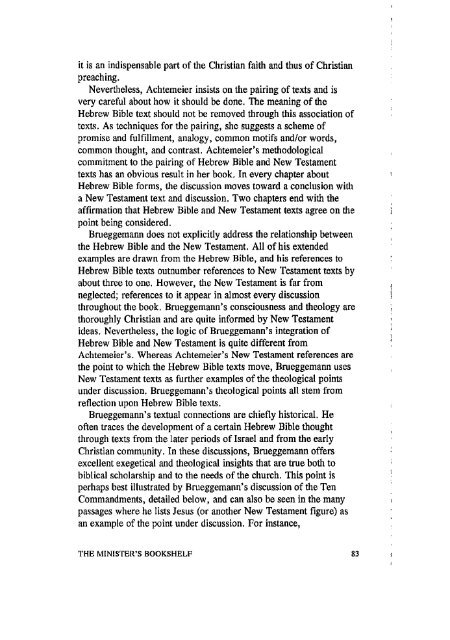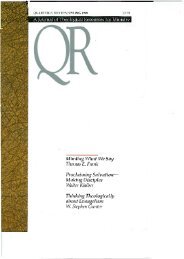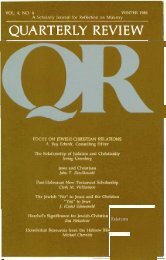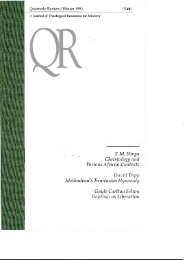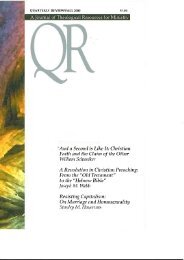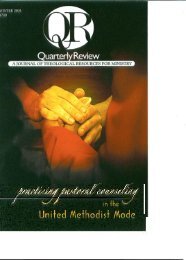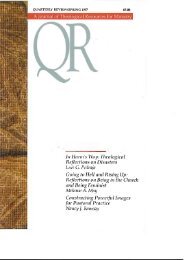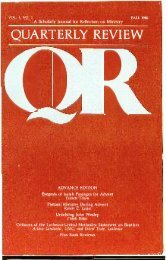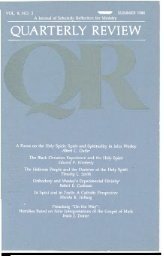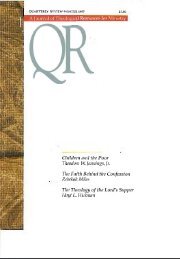TJieodore W. Jennings, Jr. The Meaning of ... - Quarterly Review
TJieodore W. Jennings, Jr. The Meaning of ... - Quarterly Review
TJieodore W. Jennings, Jr. The Meaning of ... - Quarterly Review
You also want an ePaper? Increase the reach of your titles
YUMPU automatically turns print PDFs into web optimized ePapers that Google loves.
it is an indispensable part <strong>of</strong> the Christian faith and thus <strong>of</strong> Christian<br />
preaching.<br />
Nevertheless, Achtemeier insists on the pairing <strong>of</strong> texts and is<br />
very careful about how it should be done. <strong>The</strong> meaning <strong>of</strong> the<br />
Hebrew Bible text should not be removed through this association <strong>of</strong><br />
texts. As techniques for the pairing, she suggests a scheme <strong>of</strong><br />
promise and fulfillment, analogy, common motifs and/or words,<br />
common thought, and contrast. Achtemeier's methodological<br />
commitment to the pairing <strong>of</strong> Hebrew Bible and New Testament<br />
texts has an obvious result in her book. In every chapter about<br />
Hebrew Bible forms, the discussion moves toward a conclusion with<br />
a New Testament text and discussion. Two chapters end with the<br />
affirmation that Hebrew Bible and New Testament texts agree on the<br />
point being considered.<br />
Brueggemann does not explicidy address the relationship between<br />
the Hebrew Bible and the New Testament. All <strong>of</strong> his extended<br />
examples are drawn from the Hebrew Bible, and his references to<br />
Hebrew Bible texts outnumber references to New Testament texts by<br />
about three to one. However, the New Testament is far from<br />
neglected; references to it appear in almost every discussion<br />
throughout the book. Brueggemann's consciousness and theology are<br />
thoroughly Christian and are quite informed by New Testament<br />
ideas. Nevertheless, the logic <strong>of</strong> Brueggemann's integration <strong>of</strong><br />
Hebrew Bible and New Testament is quite different from<br />
Achtemeier's. Whereas Achtemeier's New Testament references are<br />
the point to which the Hebrew Bible texts move, Brueggemann uses<br />
New Testament texts as further examples <strong>of</strong> the theological points<br />
under discussion. Brueggemann's theological points all stem from<br />
reflection upon Hebrew Bible texts.<br />
Brueggemann's textual connections are chiefly historical. He<br />
<strong>of</strong>ten traces the development <strong>of</strong> a certain Hebrew Bible thought<br />
through texts from the later periods <strong>of</strong> Israel and from the early<br />
Christian community. In these discussions, Brueggemann <strong>of</strong>fers<br />
excellent exegetical and theological insights that are true both to<br />
biblical scholarship and to the needs <strong>of</strong> the church. This point is<br />
perhaps best illustrated by Brueggemann's discussion <strong>of</strong> the Ten<br />
Commandments, detailed below, and can also be seen in the many<br />
passages where he lists Jesus (or another New Testament figure) as<br />
an example <strong>of</strong> the point under discussion. For instance,<br />
THE MINISTER'S BOOKSHELF 83


